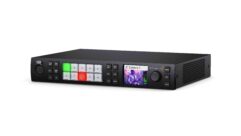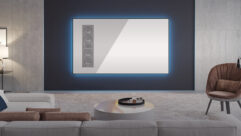
Building a New Home Theater, Part 2
Mar 16, 2009 9:15 AM,
By Jason Bovberg
Building a New Home Theater Series

As I step through the early stages of my home-theater project, I continue to take good advantage of knowledge gained from my previous home theaters, as I discussed in the first part of this series. As you can see from the photos that accompany this update, the framing is mostly finished (save for the key cosmetic framing at the front of the “stage” area), and I’m on the verge of making some essential decisions about wiring, insulation, and sound-proofing (more on those decisions next time). Until then, however, I’ve been making some other decisions that will pay off much later.
As construction takes place downstairs, I’ve spent some time upstairs—and even out of state!—buying equipment. My budget is by no means stratospheric, but at the same time, I don’t want to skimp on my dreams. This is a 15’x20’ room that I will need to fill with beautiful sound and imagery, and I want it to impress its audience—and the most important audience member to impress will be myself. That should be the goal of any home theater, right? So, over the past month, I’ve been seeking great home-theater bargains while also searching out great equipment, and I’ve managed to find a few deals. (One of the few advantages of a down economy is that such deals are often easier to come by—particularly if you’re patient.)
My first find was a terrific bargain from Costco for the Mitsubishi HC5500
front-projector that I already had my eye on. (The HC5500 would work perfectly with my room size and image-throw-distance requirements.) Costco offered the projector at a killer price, and, as part of a combo offer, was throwing in a very nice 106in. fixed-frame screen and ceiling mount. On top of that, Mitsubishi added a $300 rebate and free replacement bulb. The purchase was a no-brainer, saving me hundreds of dollars that I could instead put into construction.
I knew I would also need a new receiver for my theater, so I began that search in earnest. The reason I needed a new receiver was that my old, gorgeous, sturdy, powerhouse Denon 3800 AV receiver was incompatible with the relatively recent (and omnipresent) HDMI standard, so it wouldn’t be the best choice for my new HD theater, despite the fact that the Denon remains an extremely powerful, top-end machine. Fortunately, I’m able to put it to good use upstairs in my great room, but I knew I would need a new receiver capable of passing four HD sources (Blu-ray, HD DVD, Xbox 360, and HD cable) over HDMI to my new Mitsubishi projector. Once again in search of bargains, I started investigating a new highly regarded but generally low-end line of Onkyo receivers, and I also checked out some recent Yamaha offerings. Yes, these receivers would do what I wanted, but I admit that years with my Denon behemoth had led me to nearly fetishize the benefits of high-end aesthetics and build quality. On a trip to southern California, I stumbled on an excellent little shop called Main Street Electronics, the proprietor of which offered me a Pioneer Elite SC-05 at an incredible bargain—a bit more than I had allowed in my budget but half its list price. I couldn’t pass up the opportunity to get another powerhouse receiver to act as the foundation for my new theater. So that was my second find.
A little more research led me to my third find: the Blu-ray player I would use in the theater. I zeroed in on the Samsung BD-P2550 (purchased at a good price from Amazon.com)—among many contenders—because of its above-average DVD-upscaling capabilities. I have a substantial DVD library, and I want them to look as good as possible on the new setup. On a 106in. screen, they won’t live up to Blu-ray and HD DVD, of course, but they’ll offer a good movie-going experience. (And for those of you wondering why I’m bothering hooking up my now-“defunct” Toshiba HD DVD player, this baby still works great, and HD DVDs can be found for less than $5, if you look hard enough. HD DVD is still quite viable format in my household!)
Now, I had all the new components I needed to create excellent home-theater images and sound. To these, I would add the Atlantic Technology loudspeaker system that served me well in my previous theater. I also planned to add some kind of power-management system for the components and the ceiling-mounted projector. I was due for a long conversation with my electrician about that topic. (More next time.)
Meanwhile, I had finished framing the theater walls in such a way that I could incorporate old homemade DVD shelves that I had salvaged from my previous home. I would build them in to three spots and add loudspeaker-cloth-covered cabinet doors to conceal them. Another easy way to save cash will be to re-use my old free-standing equipment rack—I’ll simply remove the wheels, build a platform for it, and frame around it. I’ve also devised a way to access this equipment rack from behind; this concealed access panel will save me a lot of frustration while hooking up all the gear (another lesson from experience). It’s a relatively cheap, heavy-plastic, black rack, but is has sturdy shelves and a terrific smoked-glass door that will mute the LED lights of the equipment in an otherwise pitch-black room.
So, that’s where I stand, one month into the project. For my next step, electricity, I’ll make some critical decisions about lighting and power-surge protection. I’ll also wire the room for sound and video, paying special attention to future-proofing the room for technologies yet to come. (I plan to run conduit from the projector to the rack for this purpose.) After that, I’ll finish the framing, including a 12in.-high riser at the back of the room for back-row seating. Then comes one of the most important steps of the entire process: soundproofing the theater as thoroughly as possible with limited resources. I love a good challenge.
Keep in mind, I’ve love to hear about what you’ve learned from your own home-theater construction, big or small. Perhaps your experiences can help me in my process. Feel free to comment with ideas or suggestions!
Jason Bovberg (
) is a senior editor for
and
SQL Server
magazine and a regular contributor to
Residential AV Presents Connected Home
. He specializes in networking, mobile and wireless, hardware, and home computing. He has more than 15 years of experience as a writer and editor in magazine, book, and special-interest publishing.










